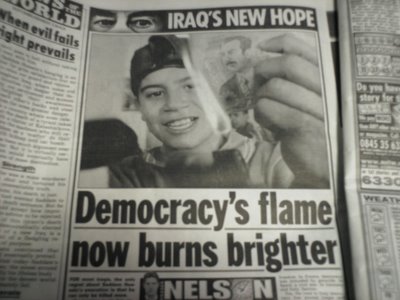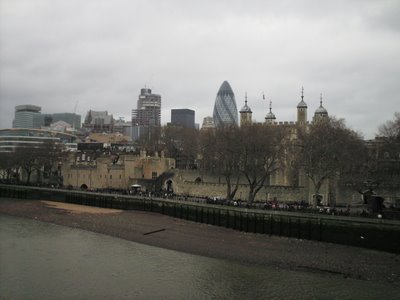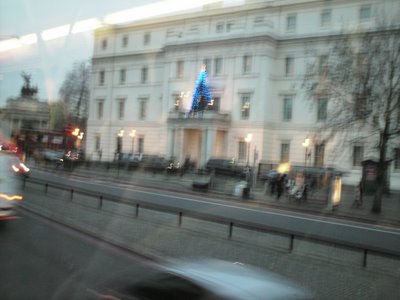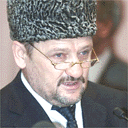
The Tsunami: More Than A Natural Disaster?
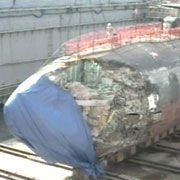
Nuclear Sub Crushed
Updated: 11:41, Friday January 28, 2005
The first pictures of an American nuclear submarine that crashed into an undersea mountain have been released.
The USS San Francisco was travelling at around 30 miles an hour when it ran aground 350 miles off the coast of Guam last month.
Pictures released by the US Navy show the front of the submarine completely cut off.
One sailor was killed and 23 others seriously injured.
A team of navy experts is preparing to assess the damage to determine whether the warship can be repaired and returned to sea.
Satellite images of the area where the submarine crashed show a wedge-shaped mountain that stretches across more than a mile of desolate expanse in the South Pacific.
Military officials told the New York Times that the mountain, which rises within 100 feet of the surface, was not on the navigation charts.
The satellite pictures suggest that the mountain is part of a larger range of undersea volcanoes and reefs.
Experts say that had the sub's active sonar system been switched on it may have been able to detect the mountain.
But US submarines usually have it switched off because when it detects anything, it makes a loud pinging noise and can give away the sub's location to potential enemies.
Nuclear Sub Crashed - Sky News Article - try searching for it now - bet you wont be able to find it unless you press this link

The Newly Rebuilt USS San Francisco - You'd never have guessed it lost its front would you?

2005 Pakistani Earthquake
The Kashmir earthquake (زلزلہ کشمیر) (also known as the South Asia earthquake or Pakistan earthquake) of 2005, was a major earthquake whose epicenter was the Pakistan-administered Kashmir. The earthquake occurred at 08:50:38 Pakistan Standard Time (03:50:38 UTC) on October 8, 2005. It registered a minimum magnitude of 7.6 on the moment magnitude scale making it a major earthquake similar in intensity to the 1935 Quetta earthquake, the 2001 Gujarat Earthquake, and the 1906 San Francisco earthquake. As of 8 November, the Pakistani government's official death toll was 73,276, while officials say nearly 1,400 people died in Indian-administered Kashmir and fourteen people in Afghanistan.

Photo of "Glowing Mountain" Following Underground Nuclear Tests in Pakistan, 28 May 1998.
The above photograph is a clip German television. It shows a mountain on the India-Pakistan border which is anomalously glowing following a series of nearby underground nuclear bomb tests. No additional information is available at this time. Special thanks to Dr. Franz Lutz of IRT in Germany for providing the photo. More information on the underground nuclear tests is given below, taken from an earlier OBRL-News posting.
NOTE: See the "Postscript September 2002" below, for a graph of meteorological data on India's monsoon rains since 1988, providing supporting evidence for the discussion given here.
Global Atmospheric-Geophysical Effects from the
India-Pakistan Nuclear Bomb Tests
May 11-13 and May 29, 1998
Two Months After -- A Preliminary Report
by James DeMeo, Ph.D.
Over 50 years ago, Wilhelm Reich observed unusual long-distance effects from above-ground nuclear tests. Dr. Reich's observations were based upon his discovery of a unique life-energetic force in the atmosphere (the orgone energy) which underlay nuclear, meteorological and biological phenomenon , much in the manner of the older physical concept of "aether" and "vital force" combined, but also with meteorolgical properties. With a nuclear bomb test, the orgone energy became highly agitated and irritated, much in the manner of irritated protoplasm, but on a much larger planetary scale -- literally, his ideas suggest the concept of the "living earth" is more than metaphor, and that the Earth's life-energy field could be highly disturbed. Reich called this disturbed/iritated phenomenon the "Oranur Effect".
In more recent years, observations on Oranur were corroborated by followers of Reich's approach (Jerome Eden, Richard Blasband, James DeMeo, Stephen Nagy) as also occurring after underground nuclear tests, and following nuclear power plant accidents. The nuclear tests or accidents create a tremendous Oranur disturbance in the energetic substrate which permeates the earth, atmosphere, and living creature; observed effects included heat waves, increased high pressure, and social/human reactions often expressed as riots or social disturbances which burst forth on the social scene in a disproportionate manner -- the human emotive-thinking process appears affected, just as is the atmospheric pressure and clouds. A patterned "downwind" hemispherical response was discovered, wherein nuclear bomb tests or accidents in Asia would be followed by heat waves in the USA within about two to three weeks. In some cases, the transition of anomalous stagnant air masses moving across the Pacific Ocean could be followed on satellite images (as an expanding cloud-free area) after the Asian bomb tests. Nuclear tests in Nevada, USA produced more immediate local results.
Other scientists who had no knowledge of Reich's earlier observations, such as Gary Whiteford, Yoshio Kato and Mitzuru Katagiri, independently observed similar anomalous long-distance effects following underground nuclear tests and/or nuclear power plant accidents. These effects included anomalous changes in global earthquake patterns, changes in upper atmospheric temperature, and anomalous perturbances in the Earth's polar motion.
All of the above individuals, with one exception, hold advanced degrees in physical or social/health sciences, and many were employed at universities. They have presented their observations in papers to various scholarly scientific societies, published in a few non-mainstream science journals, but they have been mostly ignored by the power-brokers of modern Big Science. Contemporary physics denies the possibility of such long-distance effects, as it continues to rely upon disproven and outdated assumptions of "empty space", with dismissive ignoring of data on the existence of life-energetic phenomena (such as the human energy field) or related concepts in geophysics (such as the Earth's energy field, which is similar in some respects to geomagnetism).
Most environmental groups, having fought for years to gain a foothold in the halls of academic and political power, likewise refuse to consider the reality of these long-distance anomalous effects from nuclear bomb tests and power plant accidents. Nevertheless, the effects appear real, and sufficiently documented to satisfy all but the most intractable critic that there is something going on that deserves a public airing of the issue, and further investigation. (Full citations on all the above mentioned individuals and effects, with pertinent article reprints, can be found in the publication "Unusual, Long-Distance Atmospheric and Geophysical Effects from Underground Nuclear Bomb Tests and Nuclear Power Plant Accidents", available for $7 postpaid from Natural Energy Works, PO Box 1148, Ashland, Oregon 97520 USA).
Here is a chronology of recent events following the unprecedented testing of ten nuclear bombs by India and Pakistan all within a few days time, and in the same geographical region, with a spreading eastward of the disturbance over ensuing weeks.
11-13 May: India tests five (5) nuclear bomb tests underground at its test site near the Pakistan border. The explosions measured up to 5.6 Magnitude on the world's seismological network. Yields were said to be around 10 KT.
22 May: Killer heat wave hits India and Pakistan, with temperatures up to 120 F, and 34 dead as of this date. "the lingering early-season heat wave is unusually severe". The heat wave occurred so quickly after the nuclear tests, and ordinary citizens in the region were asking questions about the relationship between the two events so frequently, such that the Indian Meteorological officials made a public statement denying any relationship.
27 May: China reports massive flooding. 128 dead (The floods in China appear related to a high-pressure blockage over India of Easterly winds, which were forced northward to dump their moisture along the eastern edge of the Tibetan Plateau.)
28 May: Pakistan tests five (5) nuclear bomb tests underground at its test site near the Indian border. The explosions measured up to 4.6 Magnitude.
29 May: "366 Dead in India Heat Wave" Temperatures up to 122 F. "Most devastating heat wave in years"
30 May: Killer earthquake in Afghanistan. 2,500 dead, 6.9 Magnitude.
1 June: Another 100 dead in India Heat Wave.
5 June: Heat wave in India/Pakistan death toll up to 1,359 persons.
5 June: Swarms of tornadoes across the USA. Spencer, South Dakota is wiped off the map. Also in Michigan, Tennessee, Pensylvania and New York -- regions where tornadoes are highly unusual.
12 June: Heat wave in India/Pakistan death toll now at 2,500 persons.
12-19 June: China reports flooding, 100,000 persons evacuated, 40 deaths.
19 June: "Weather block" reported across USA, in place for several weeks (back dates approximately to the time of the Pakistani tests). Florida going bone-dry. Considered to be the by-product of "heat from the expired El Nino" (If El Nino has "expired" then from where does the heat come? This statement is highly over-reaching, searching for an answer, but falls short due to lack of adequate mechanism.)
3 July: Wildfires across Florida. Tens of thousands evacuated. Heat wave and smokes from Mexico to Texas to Florida.
3 July: Severe monsoon storms wreak havoc in Sri Lanka. 60 mph winds. Nature is pushing agains the blockage.
9 July: Subtle shift in tropical weather globally: Fires weaken in Florida, rains developing in drought areas of Africa, India, etc.
18 July: Heat wave now moving north, spreading into Midwest and West USA.
In addition to the above, civil riots also errupted in parts of India and Indonesia following the nuclear tests, and a wholely unanticipated border war errupted between Eritrea and Ethiopia (whose leaders are former allies).
Based upon the above, it would appear the global effects from the ten India/Pakistan atomic bomb tests of May 1998 included:
* Over 5,500 persons dead from earthquake, heat wave, and flood.
* Approximately 200,000 persons forced to evacuate homes in China and Florida, to escape the effects of flooding and wildfire, respectively.
* Financial costs are unknown, but surely must be over 1 Billion US dollars.
* The final chapter has not yet been written: heat wave conditions which started after the nuclear tests may persist in the USA and elsewhere.
It is difficult to say whether the spreading north of the oranur heat wave conditions into the Midwestern USA will be only temporary. It is possible the oranur effect which firstly irrupted in India/Pakistan attendant to the nuclear tests, which later spread regionally and eventually east across the Indian and Pacific Oceans into North America (primarily into Mexico and the southern USA states) is now moving again. If so, the East Coast should be affected soon, followed by Europe as it continues eastward.
Citations to the above chronological events will be provided in a published version of this article, but are otherwise available from Earthweek, and via wire service reports in most major newspapers over the last several months.
See: "Unusual, Long-Distance Atmospheric and Geophysical Effects from Underground Nuclear Bomb Tests and Nuclear Power Plant Accidents", available for $7 postpaid from Natural Energy Works, PO Box 1148, Ashland, Oregon 97520 USA.
OBRL-News is scaled-down at least until mid-September when the Lab's summer field research program in Africa is completed.
**********

Dr. Abdul Qadeer Khan (Urdu: عبدالقدیر خان )(b. 1935) is a Pakistani Scientist and Metallurgical Engineer widely regarded as the founder of Pakistan's nuclear programme and also credited as the father of the Pakistani nuclear black market. (His middle name is also, occasionally, rendered as Quadeer, Qadir or Gadeer and his given names are often abbreviated to A.Q.). In January 2004, he confessed to having been involved in a clandestine international network of nuclear weapons technology proliferation from Pakistan to Libya, Iran and North Korea. On February 5, 2004, the President of Pakistan, General Pervez Musharraf, announced that he had pardoned Dr. Abdul Qadeer Khan. Despite this political scandal he is still regarded as the Hero of the Nation by virtually all Pakistanis.
In a August 23, 2005 interview with Kyodo News General Pervez Musharraf confirmed that Dr. A.Q. Khan had supplied gas centrifuges and gas centrifuge parts to North Korea and, possibly, an amount of uranium hexafluoride gas.[1]
